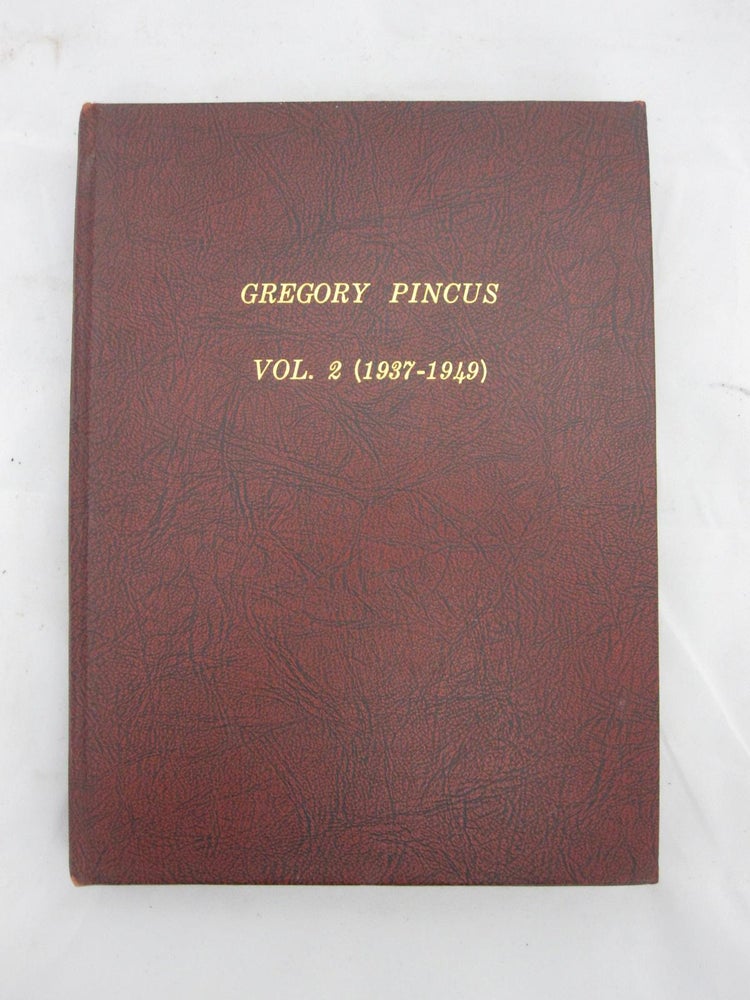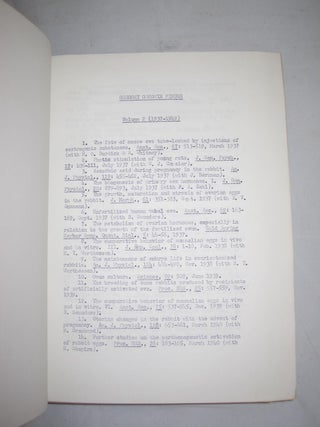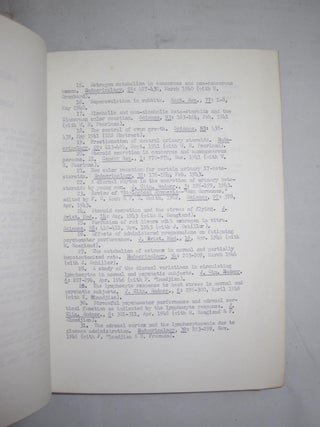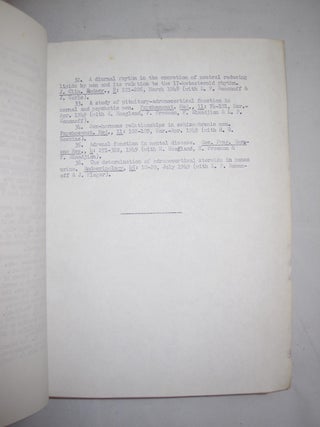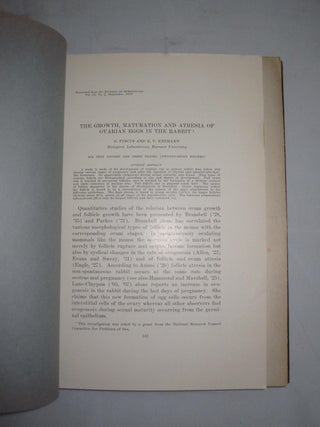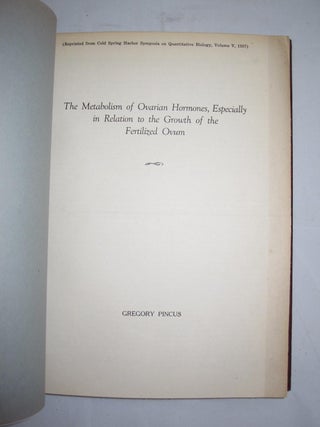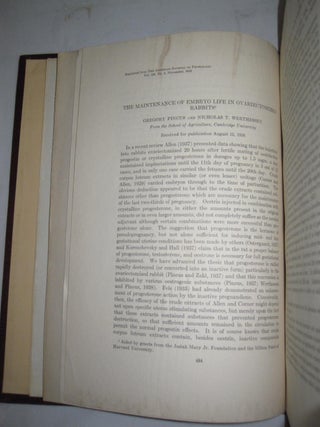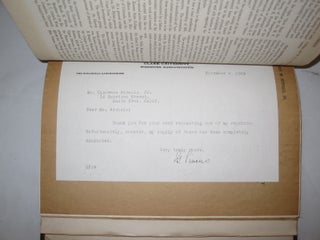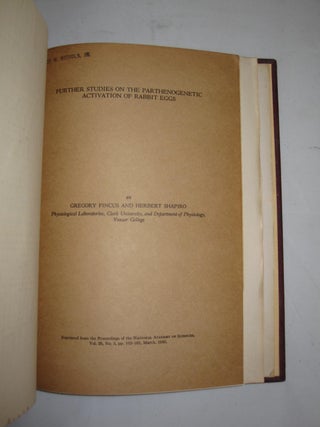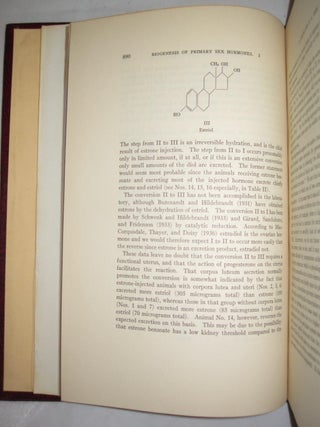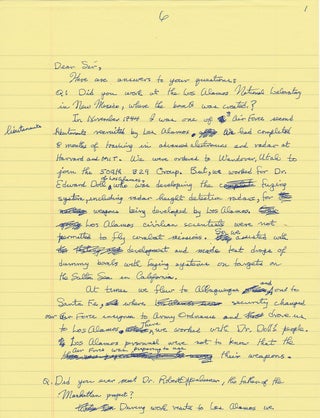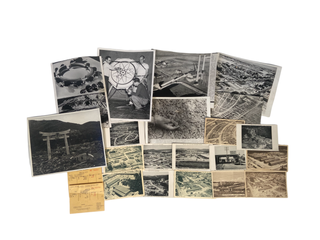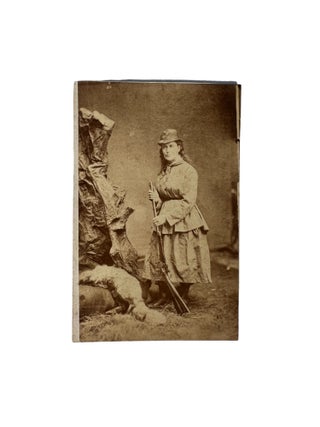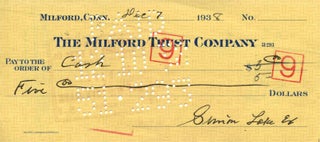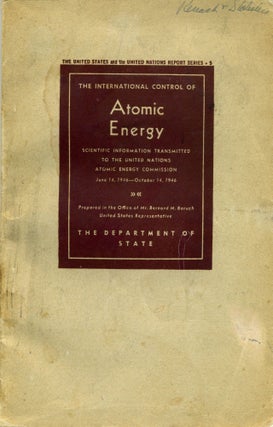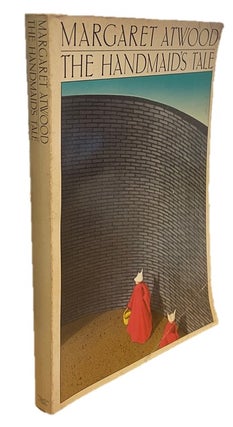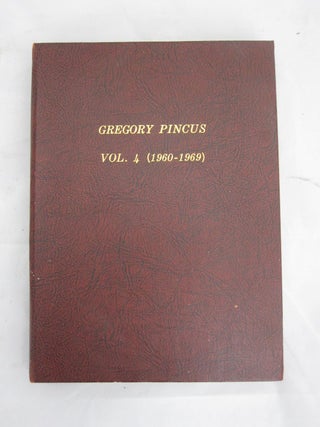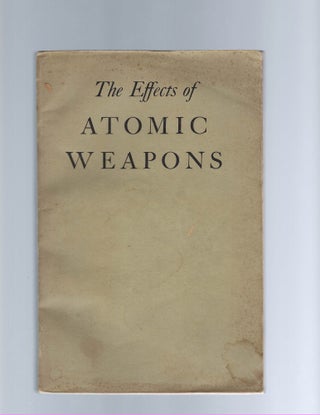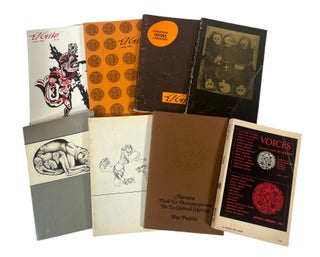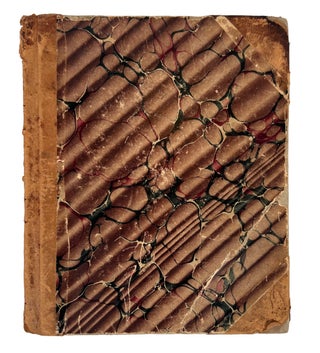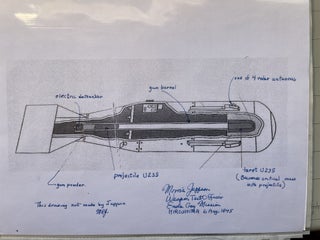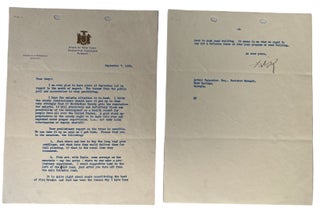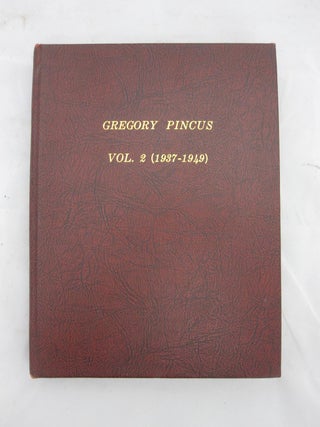The Fundamental papers on the creation of the Contraception Pill - Gregory Pincus Archive of 36 Rare Bound Offprints Documenting his Research on Reproduction and Contraception and TLS (1937-1949)
Archive
[Contraception] Gregory Pincus. Father of The Oral Contraceptive Pill. Bound collection of 36 rare offprints of Pincus’s scientific publications on fertility research and in vitro fertilization. 367 pages in total. 10.5 x 7.5 in. Dark red textured cloth boards. “Gregory Pincus Vol. 2 (1937-1949)” gilt on front cover. “Gregory Pincus Vol. 2” gilt on spine. Most offprints bound with original paper wrappers. Comes with 1 Typed Letter Signed by Pincus on Clark University letterhead, dated November 6, 1939. Scientific writings from Pincus’s research on fertility and in vitro fertilization. Most of this work comes from the time after he was forced out of Harvard University, due to his controversial--yet groundbreaking--experiments with in vitro and parthenogenetic reproduction in rabbits. In 1938, he joined the faculty at Clark University in Worcester, MA and in 1944, he co-founded the Worcester Foundation for Experimental Biology with Hudson Hoagland. At these institutions, Pincus continued his pioneering research in mammalian reproduction and steroid hormone use. His outstanding work in this field brought him to the attention of Margaret Sanger, who met with him in 1951 and supported his work towards developing the oral contraceptive pill.Pincus’s work from this period focuses on understanding the effects of different sex hormones on ovum development, and gaining a better understand of human fertility as his work before this time primarily focused on small mammals such as rabbits and mice. In “Comparative Behavior in of Mammalian Eggs in Vivo and in Vitro. III.”, Pincus writes how they “have attempted to influence the course of ovum growth in utero chiefly by the injection of biologically active substances which might, on theoretical grounds, affect the growth process.” In “Comparative Behavior in of Mammalian Eggs in Vivo and in Vitro. VI. The maturation of human ovarian ova” from 1939, Pincus experiments with human ova and sperm in vitro to see how hormonal environments can affect egg maturation. “Although woman is commonly recognized as spontaneously ovulation, it is remarkable that almost no ova in maturation division have been observed in human ovaries...It was considered a matter of some interest, therefore, to determine if human ova upon explanation would exhibit the same behavior as rabbit ova, ie. to see whether a maturation potency inhibited in vivo would be expressed in vitro, and to ascertain whether the usual ovum activating treatment would accelerate maturation.” In “Unfertilized Human Tubal Ova” (1939) Pincus works to understand important timelines in women’s ovulation cycle. This research is significant as ‘The Pill’ works by suppressing ovulation through hormone administration. “...this ovum was obviously long post-ovulatory but tubal it seems likely that the ovulation occurred in this case between the fourteenth and sixteenth days of the citycle or between 12 and 14 days before the end of the cycle.” His work continued to spark controversy, and Pinucs directly addresses false rumors that he intends to produce “human offspring” in “Ovum Culture”: “”In certain press report of a recent paper on meiosis in explanted human ovarian ova the statement has appeared that I plan to carry on this work to the extent of attempting to discover if human offspring can be produced by the methods we employ in ovum culture. This statement is incorrect. My work with human ova ended with these studies of maturation, and I have no intention whatsoever of continuing them.”
Offprints are the rarest and most collectible forms that a journal article can take. Few are printed, perhaps only two or three, and these are usually given to the authors of the piece. Sometimes authors give them away to colleagues, so it’s not unusual to find offprints with presentation inscriptions or important ownership signatures. Comes with Typed Letter Signed by Pincus on Clark University letterhead, dated November 6, 1939 regarding the scarcity of offprints. “Thank you for your card requesting one of my reprints Unfortunately, however, my supply of these has been completely exhausted.” Signed “G. Pincus” in black ink.
Selection of the 36 offprints listed below. Complete index included in object photographs. All are incredibly rare. Unless noted, at the time of this writing, there are no copies of this offprint in any institutional or library collections, as per OCLC Worldcat:
“The fate of mouse ova tube-locked by injections of oestrogenic substances.” The Anatomical Record, Vol. 67, March 1937.
“Ascorbic acid during pregnancy in the rabbits.” American Journal of Physiology, Vol. 119, July 1937.
“Biogenesis of primary sex hormones. I. The fate of estrins injected into the rabbit.” The Journal of General Physiology, Vol. 20, No. 6, July 1937.
“Unfertilized human tubal ova.” The Anatomical Record, Vol. 69, September 1937.
“The metabolism of ovarian hormones, especially in relation to the growth of the fertilized ovum.” Cold Spring Harbor Symposium on Quantitative Biology, Vol. 5, 1937. Only 1 copy held by an institutional collection, according to OCLC Worldcat.
“The comparative behavior of mammalian eggs in vivo and in vitro. III. Journal of Experimental Zoology, February 1938.
“The Maintenance of embryo life in overiectomized rabbits.” American Journal of Physiology, Vol. 124, November 1938. Only 1 listing in a institutional collection, according to OCLC Worldcat
“The breeding of some rabbits produced by recipients of artificially activated ova.” Proceedings of the National Academy of Sciences, Vol. 25, November 1939. Only 1 listing in a institutional collection, according to OCLC Worldcat.
“The comparative behavior of mammalian eggs in vivo and in vitro. VI. The maturation of human ovarian ova.” The Anatomical Record, Vol 75, December 1939. Only 1 listing in a institutional collection, according to OCLC Worldcat.
“Further studies on the parthenogenetic activation of rabbit eggs.” Proceedings of the National Academy of Sciences , Vol. 26, March 1940. Only 1 listing in a institutional collection, according to OCLC Worldcat.
“Superovulation in rabbits,” The Anatomical Record, Vol. 77, May 1940. Only 1 listing in a institutional collection, according to OCLC Worldcat.
“Perfusion of rat livers with estrogen in vitro.” Science, Vol, 98, November 1943.
“The breeding of some rabbits produced by recipients of artificially activated ova.” Proceedings of the National Academy of Sciences. Vol. 25, no. 11, Nov. 1939. Only 1 listing in a institutional collection, according to OCLC Worldcat.
Item #16897
Price: $4,500.00
See all items by Gregory Pincus

